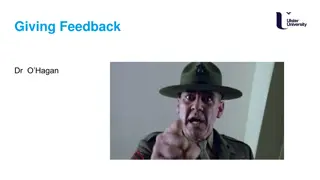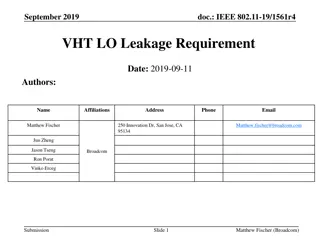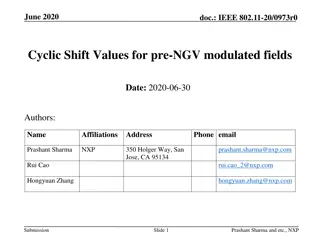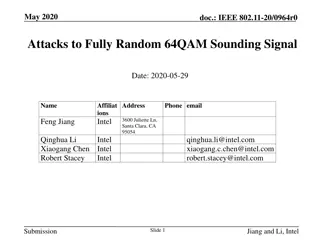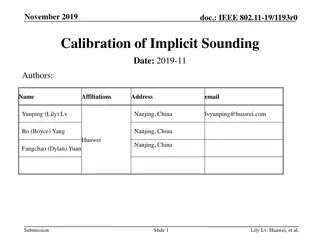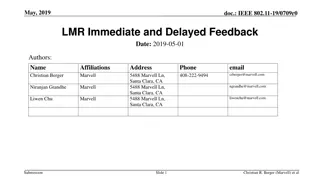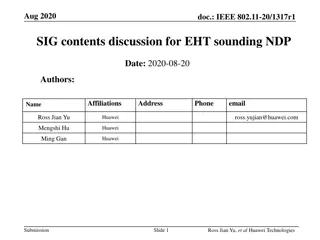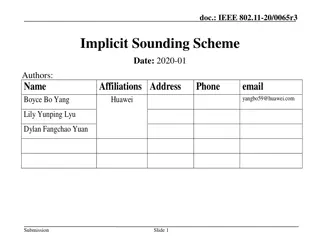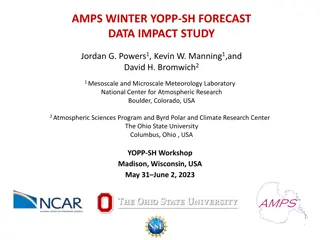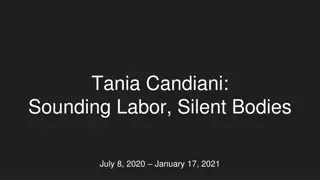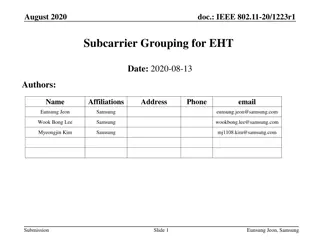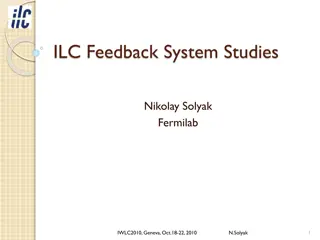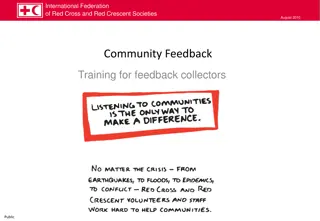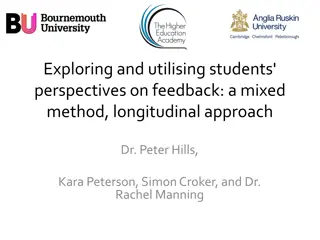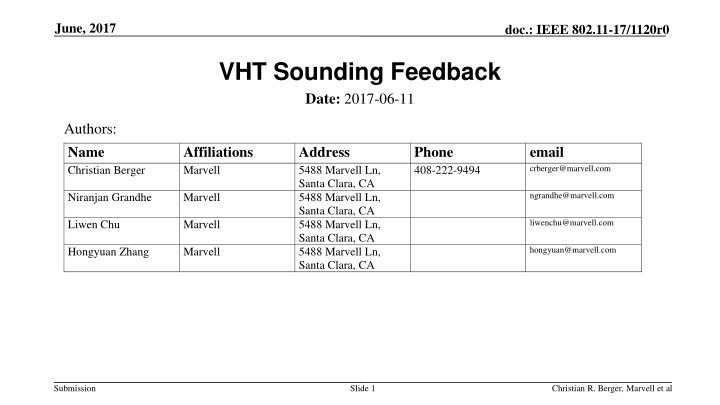
IEEE 802.11-17 VHT Sounding Feedback Protocol Overview
Explore the June 2017 document on IEEE 802.11-17/1120r0 VHT Sounding Feedback Protocol, discussing aspects like Location Measurement Report (LMR), SIFS timing, and open questions. Understand the ToA and CSI feedback mechanisms within SIFS and the implications for initiators and responders in wireless communication settings.
Download Presentation

Please find below an Image/Link to download the presentation.
The content on the website is provided AS IS for your information and personal use only. It may not be sold, licensed, or shared on other websites without obtaining consent from the author. If you encounter any issues during the download, it is possible that the publisher has removed the file from their server.
You are allowed to download the files provided on this website for personal or commercial use, subject to the condition that they are used lawfully. All files are the property of their respective owners.
The content on the website is provided AS IS for your information and personal use only. It may not be sold, licensed, or shared on other websites without obtaining consent from the author.
E N D
Presentation Transcript
June, 2017 doc.: IEEE 802.11-17/1120r0 VHT Sounding Feedback Date: 2017-06-11 Authors: Name Christian Berger Affiliations Marvell Address 5488 Marvell Ln, Santa Clara, CA 5488 Marvell Ln, Santa Clara, CA 5488 Marvell Ln, Santa Clara, CA 5488 Marvell Ln, Santa Clara, CA Phone 408-222-9494 email crberger@marvell.com ngrandhe@marvell.com Niranjan Grandhe Marvell liwenchu@marvell.com Liwen Chu Marvell hongyuan@marvell.com Hongyuan Zhang Marvell Submission Slide 1 Christian R. Berger, Marvell et al
June, 2017 doc.: IEEE 802.11-17/1120r0 Recap VHT Sounding Protocol NDP-A NDP Initiator SIFS SIFS NDP LMR Responder SIFS+X Protocol is completely unscheduled When medium is idle, initiator can send NDP-A followed by NDP If available, responder replies with NDP within SIFS After SIFS+X LMR is fed back to initiator Submission Slide 2 Christian R. Berger, Marvell et al
June, 2017 doc.: IEEE 802.11-17/1120r0 Open Questions What is in the Location Measurement Report (LMR) Ideally includes t2 (ToA) and t3 (ToD). similarly to legacy FTM protocol Could also include raw CSI and t2 and t3, where t2 can be derived from FFT window start t2 and CSI (find first path) What does SIFS + X mean Ideally X=0, the initiator has all it needs and can go off channel X>0 could be needed for some implementations to finish calculating t2 or even to get the CSI ready Submission Slide 3 Christian R. Berger, Marvell et al
June, 2017 doc.: IEEE 802.11-17/1120r0 Discussion Case for ToA report within SIFS Possible for responders with ToA algorithm in hardware Ideal case for initiators, half the work already done Full transactions is finished within one TxOP, no need for buffers at responder or need for initiator to wait/come back Case for CSI Feedback Low cost responder might not have the computational muscle or implementation complexity to accurately calculate ToA Can completely outsource this task to initiator CSI should be easily available after SIFS, or shortly thereafter Submission Slide 4 Christian R. Berger, Marvell et al
June, 2017 doc.: IEEE 802.11-17/1120r0 Which is the Mandatory Mode? ToA Feedback within SIFS Any initiator who can accept CSI feedback can also accept ToA (ultimately CSI is used to calculate ToA) Limitation on the responder, how accurate a ToA can be calculated within SIFS, any? Not all responders can be expected to implement this CSI Feedback A responder who already supports ToA within SIFS might not want to offer also CSI feedback Not every initiator has the ability to process CSI Since this CSI format is new, making it mandatory adds huge cost Submission Slide 5 Christian R. Berger, Marvell et al
June, 2017 doc.: IEEE 802.11-17/1120r0 Need for a Mandatory Mode The mandatory LMR mode needs to include ToA The responder needs enough time to calculate ToA Base it on current FTM ToA is assumed ready for transmit at next FTM packet MinDeltaFtm can be between 1-255 in 0.1 ms increments Typically 0.5-1.5 ms is used This is implementable How about efficiency? Submission Slide 6 Christian R. Berger, Marvell et al
June, 2017 doc.: IEEE 802.11-17/1120r0 Implementation MaxToaAvailable MinToaReady Sounding LMR Availability Time [ms] FTM Setup/Negotiation Responders declares MinToaReady similar to MinDeltaFtm Tells the initiator when to expect LMR After this interval the responder will try to send the LMR to the initiator (use RTS/CTS to see if initiator is there) Responder also declares MaxToaAvailable Tells the initiator how long LMR will be stored The initiator can pull the LMR from the responder by starting a new sounding sequence (staggered feedback) or by sending a PS poll Submission Slide 7 Christian R. Berger, Marvell et al
June, 2017 doc.: IEEE 802.11-17/1120r0 Case 1: Stay on Channel If MinToaReady < 3 ms Makes sense for initiator to camp on channel Activate power save for programmed time Responder will send LMR after MinToaReady, once channel is idle If MaxToaAvailable < 10 ms The responder could choose a small MaxToaAvailable to encourage initiators to stay on channel This reduces need for large buffers Possibly attempt transmitting LMR once more at MaxToaAvailable (RTS-CTS) Submission Slide 8 Christian R. Berger, Marvell et al
June, 2017 doc.: IEEE 802.11-17/1120r0 Case 2: Go off Channel If MinToaReady > 10 ms Makes sense for initiator to go off channel Come back before MaxToaAvailable expires Pull LMR explicitly or start new sounding Submission Slide 9 Christian R. Berger, Marvell et al
June, 2017 doc.: IEEE 802.11-17/1120r0 Summary ToA should be mandatory All 11az STA should be able to provide some sort of ToA Low cost STA can advertise CSI feedback capability to increase possible accuracy when acting as responder High performance APs will offer ToA feedback after SIFS as responder by setting MinToaReady and MaxToaAvailable to 0 Submission Slide 10 Christian R. Berger, Marvell et al

